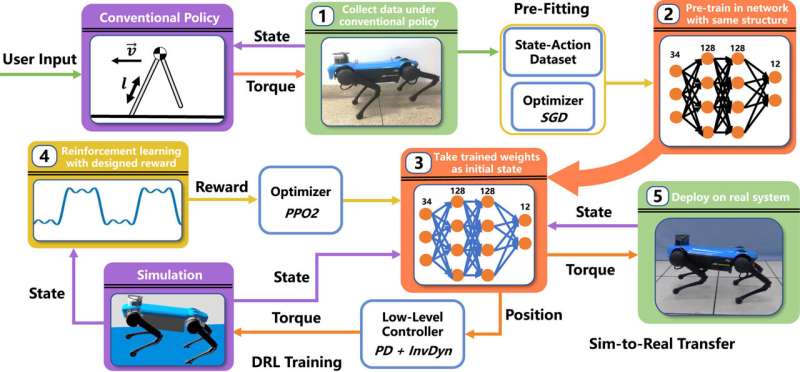This article has been reviewed according to Science X's editorial process and policies. Editors have highlighted the following attributes while ensuring the content's credibility:
fact-checked
proofread
Research improves quadruped bounding with efficient learning method

In a study published in special issue of the journal IET Cyber-Systems and Robotics, researchers from Zhejiang University experienced in legged robot motion and control, pre-trained the neural network (NN) using data from a robot operated by conventional model-based controllers.
This pre-training served as a preliminary measure to prevent behavior overriding and reward hacking—a situation where agents secure rewards unexpectedly, typically due to the optimization inadvertently reaching a local optimum rather than the intended one. Following the pre-training, the team implemented deep reinforcement learning (DRL), a trendsetting learning-based approach in legged locomotion control.
Notably, a reward function was designed considering contact points and phases, which enforced gait symmetry and periodicity, culminating in an improved bounding performance. The DRL methods developed were initially learned in a simulated environment and then successfully deployed on a real quadruped robot, the Jueying Mini.
The resultant locomotion was tested across various environments, both indoors and outdoors, demonstrating efficient computing and excellent locomotion results. The control method developed for the Jueying Mini robot was found to yield robust bounding gaits in both simulation and real-world settings. This has tremendous implications for enhancing the agility and adaptability of quadruped robots in varied indoor and outdoor environments.
The study's next steps involve integrating the current method with environmental perception tools, such as cameras or LiDAR systems. While these were not used in the current study, they can offer more accurate localization of the robot and navigation for bounding across different terrains.
In another study published in the special issue, researchers have pioneered the use of control moment gyroscopes (CMGs) in improving biped robots' stability, particularly during high-speed operations. Biped robots, increasingly used across industries, struggle with balance and disturbance rejection as their speed increases.
The newly developed CMG assistance strategy enhances their ability to resist impact and quickly regain balance. Simulation results confirm the CMGs' effectiveness in significantly enhancing robots' stability. This innovative use of CMGs represents a leap in biped robotics, with plans to further integrate CMGs for improved real-world performance in high-dynamic motions.
More information: Zhicheng Wang et al, Efficient learning of robust quadruped bounding using pretrained neural networks, IET Cyber-Systems and Robotics (2022). DOI: 10.1049/csy2.12062
Haochen Xu et al, Disturbance rejection for biped robots during walking and running using control moment gyroscopes, IET Cyber-Systems and Robotics (2022). DOI: 10.1049/csy2.12070















